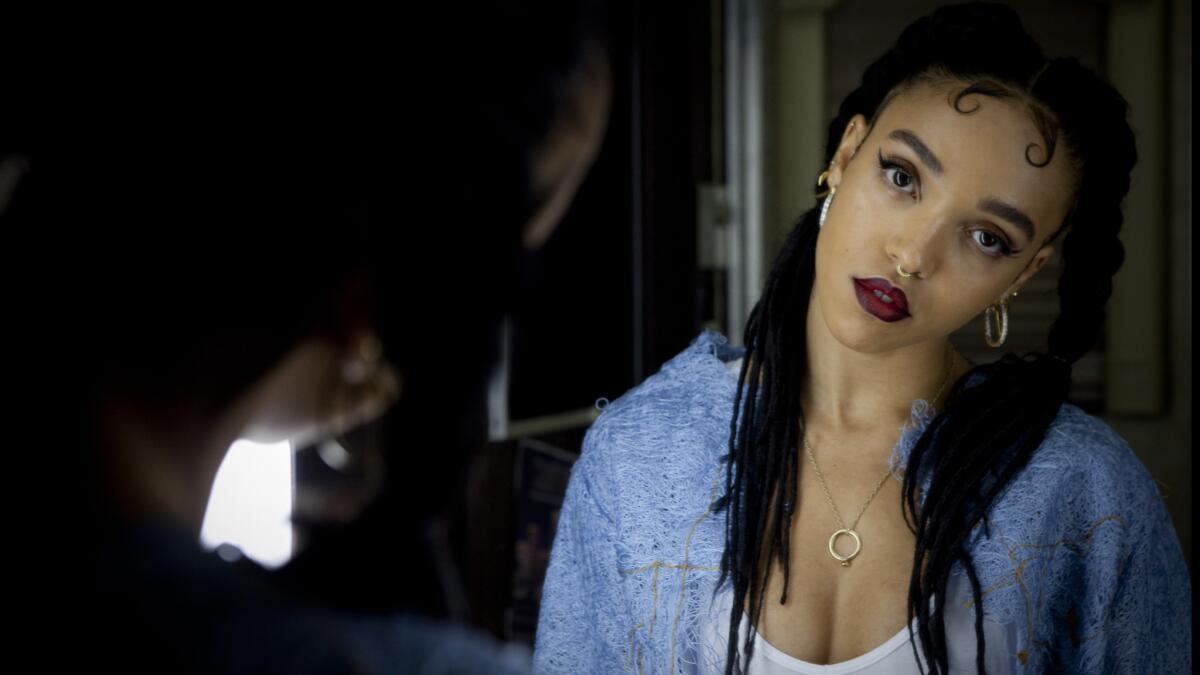Why FKA twigs pole dances in Grammy-nominated ‘Cellophane’

- Share via
The sound of applause is not enough to drown out the clicks of FKA twigs’ sky-high stilettos as she saunters across a stage in the Grammy-nominated video “Cellophane.” Wearing a sparkling bikini, her body undulates like molten lava against a pole as the song of vulnerability begins.
Its lyrics are set to a spare piano: Didn’t I do it for you Why don’t I do it for you/ Why won’t you do it for me/ When all I do is for you.
Then, she’s spinning on the pole, upside down with her legs contorted above her head, as the sky opens up and an alien-like creature appears.
Directed by Björk collaborator Andrew Thomas Huang, the video marked twigs’ return after a three-year hiatus. She took time away from performing to make new music, train in different movement styles and heal from an operation removing benign fibroid tumors from her uterus.

FKA twigs “Cellophane” video was nominated for a Grammy.
From the early days of her career, twigs, whose experimental sound blends electronic with pop and R&B, has made dance an integral component of her artistry.
Since releasing her first music project in 2012, she’s experimented with ways to combine her music with movement, working with Hollywood choreographer Ryan Heffington, voguer Benjamin Milan, krumping troupe Wet Wipez and others from the global dance community.
For “Cellophane,” she had to learn a new skill.
The video concept came to twigs immediately after writing the song in 2018. “It was supposed to be seductive, but also uncomfortable to watch,” she said.
We talked to L.A. dancers who were once deemed nontraditional but are now breaking into the mainstream on video-centric platforms, including YouTube, Instagram and TikTok, to become celebrities in their own right.
To make the pole dancing look effortless on camera, twigs studied intensely with L.A. choreographer and pole instructor Kelly Yvonne for about a year. Early training sessions were painful.
“At a certain point, you stop feeling it and your body gets used to it,” twigs said. “The pole becomes your best friend and the harder you squeeze, the tighter the burn, the more exhilarating it is.”
Pole dance is just one of the movement skills twigs showcased during her recent tour for her latest album, “Magdalene.”
When twigs began conceptualizing the show with Theo Adams, the founder of a London-based performance collective, they spent a week trading ideas with Canadian performance art duo Quote Unquote Collective.
Working with Adams, the two further developed the live show, steeped in the centuries-old Italian street theater tradition of commedia dell’arte. The goal was to use old-fashioned theater techniques and archetypes to present twigs’ raw talent to audiences.
In the show, twigs tap dances as a jester and does contemporary and street dance in Harlequin-inspired costumes with a cast of performers. A pole routine is set to “Lights On,” a song from her debut album. And at one point, she sets aside her microphone and grabs a sword to perform an agile number showing off her skills in the Chinese martial art wushu.
“I’m still a beginner, but I want to just put it onstage so I could show everyone where I am,” twigs said. “It’s kind of fun to be vulnerable and be a work in progress.”
When twigs performed a shortened version of the show last year at the L.A. festival Camp Flog Gnaw, the crowd stood mesmerized as she moved. Even outdoors, a cellphone ring pierced the awed silence.
Working with twigs was easy, Adams said. “She’s like an old school pro-performer,” he said. “She’s got it and there’s not many people around nowadays in the world that have that.”
Born Tahliah Barnett, twigs grew up in the English countryside of Gloucestershire. She began taking ballet, tap and modern dance classes at 7, learned to salsa dance at 8, and around 12 began training in street dance and hip-hop.
At 17, she moved to South London and became a backup dancer for British pop artists including Jessie J and Ed Sheeran. Dance is “just something that’s inside of me,” she said. “My dad was a jazz dancer. My mom’s a salsa dancer.”
But in the early days of her music career, she wanted to distance herself from dance.
“I really did not want to be known as a dancer,” she said. “I wanted to do some movement onstage and I wanted to express myself a little bit, but I really did not want to put dance into what I do.”
After signing to her music label Young Turks, someone from the artists and repertoire division told her, “if you dance, you’re not going to be taken seriously.”

Twigs said dance can make or break an artist.
“It really is super-exposing. In the beginning, I was really nervous to have dance,” she said adding that when she rose through the ranks, not many pop artists were incorporating underground cultures like voguing. “They haven’t done it for a long time.”
The turning point was creating “Soundtrack 7,” a short film fusing contemporary with street dance, created during a 2015 residency at Manchester’s Old Granada Studios as part of the Manchester International Festival.
“That was when I was like, ‘Oh wait, I’ve still got it,’” she said. “It’s still in here somewhere — this classical training, the contemporary training.”
These days, twigs hesitates to call herself a dancer, instead preferring to invoke the term “movement artist,” one investigating “what my body can do and seeing how that relates to beats and music and sounds.”
“I used to be a dancer and now I’m a mover and it’s just different,” she said “I can’t explain how it’s different, but it just is.”
More to Read
The biggest entertainment stories
Get our big stories about Hollywood, film, television, music, arts, culture and more right in your inbox as soon as they publish.
You may occasionally receive promotional content from the Los Angeles Times.












